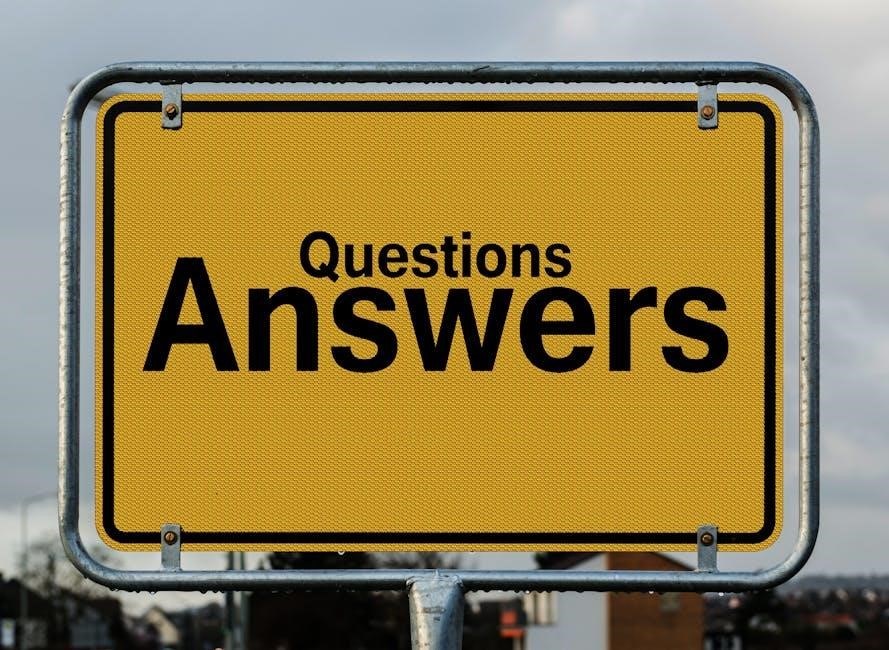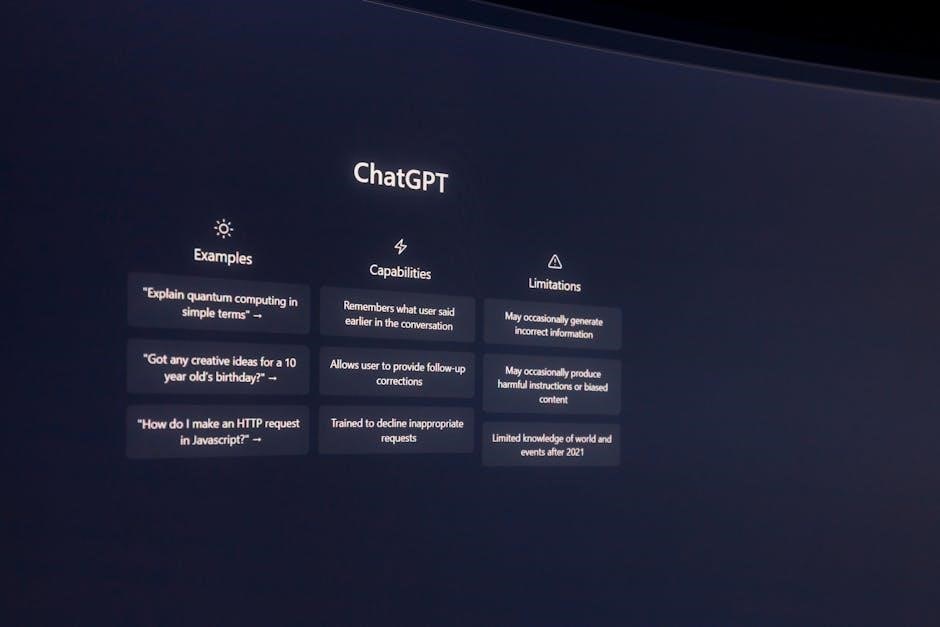Explicit sentence comprehension instruction involves systematic teaching of strategies to enhance reading proficiency. It includes direct explanations‚ modeling‚ guided practice‚ and independent application of comprehension techniques to foster understanding.
Definition of Explicit Sentence Comprehension Instruction
Explicit sentence comprehension instruction refers to a systematic and intentional approach to teaching reading strategies. It involves clear explanations‚ demonstrations‚ and guided practice to help students decode and understand sentences. This method emphasizes direct teaching of skills‚ such as identifying main ideas‚ summarizing‚ and answering questions. Unlike implicit instruction‚ it removes ambiguity by explicitly showing students how to apply strategies. Teachers model thinking aloud‚ break down complex tasks‚ and provide feedback to ensure mastery. The goal is to equip students with tools to independently comprehend and interpret texts‚ fostering both accuracy and fluency in reading. This approach is particularly effective for struggling readers.
Importance of Explicit Instruction in Reading Comprehension
Explicit instruction is crucial for developing reading comprehension skills as it provides clear‚ structured guidance. Unlike implicit methods‚ explicit teaching breaks down strategies into manageable steps‚ ensuring students understand how to apply them. This approach is especially beneficial for struggling readers‚ as it reduces confusion and builds confidence. By directly explaining concepts and modeling techniques‚ teachers empower students to tackle complex texts independently. Research shows that explicit instruction enhances reading proficiency‚ improves academic performance across subjects‚ and fosters a deeper understanding of content. It equips students with lifelong reading skills‚ making it a cornerstone of effective literacy education.
Overview of Key Components
Explicit sentence comprehension instruction involves a structured approach to teaching reading strategies. Key components include direct explanation of techniques‚ teacher modeling through think-alouds‚ and guided practice with feedback. These elements ensure students grasp how and when to apply strategies. The instruction also emphasizes independent application‚ allowing learners to use skills autonomously. Additionally‚ it incorporates metacognitive practices‚ such as monitoring understanding‚ and the use of graphic organizers to visualize relationships. Vocabulary instruction and sentence-level techniques‚ like identifying structure and simplifying sentences‚ are also integral. Together‚ these components create a comprehensive framework that addresses various aspects of reading comprehension‚ ensuring students develop the skills needed to interpret and analyze texts effectively.

Key Components of Explicit Sentence Comprehension Instruction
Explicit instruction includes direct explanation of strategies‚ teacher modeling‚ guided practice‚ and independent application. These components ensure students understand and apply comprehension techniques effectively in their reading.

Direct Explanation of Strategies
Direct explanation involves teachers clearly defining comprehension strategies and explaining their purpose. This component ensures students understand why and when to use specific techniques‚ enhancing their ability to apply them effectively. By breaking down strategies into manageable steps‚ educators provide a foundation for independent reading. This approach is essential for struggling readers‚ as it removes ambiguity and offers explicit guidance. Research highlights that direct explanation improves students’ ability to identify main ideas‚ summarize texts‚ and engage in metacognitive thinking. It is a cornerstone of explicit instruction‚ setting the stage for successful implementation of other instructional components.
Teacher Modeling and Think-Alouds

Teacher modeling and think-alouds involve educators demonstrating comprehension strategies by verbalizing their thought processes while reading. This makes the invisible act of understanding visible to students. By sharing their inner dialogue‚ teachers illustrate how to identify main ideas‚ ask questions‚ and make connections. This approach demystifies the reading process‚ showing students how skilled readers engage with text. It also helps students develop metacognitive skills‚ as they observe how to monitor and repair comprehension. Through modeling‚ teachers provide a clear blueprint for students to emulate‚ fostering independence and confidence in applying strategies. This interactive method bridges the gap between instruction and application‚ making abstract concepts tangible for learners.
Guided Practice with Feedback
Guided practice with feedback involves collaborative activities where students apply comprehension strategies under teacher supervision. After modeling‚ students engage in structured exercises‚ such as group discussions or paired reading‚ to practice techniques like summarizing or questioning; Teachers circulate to offer real-time support‚ addressing misconceptions and reinforcing effective strategies. Immediate‚ specific feedback is provided to refine understanding and build accuracy. This scaffolded approach ensures students grasp concepts before advancing to independent tasks. Feedback not only corrects errors but also highlights strengths‚ fostering confidence and fluency. Guided practice bridges the gap between instruction and self-directed learning‚ ensuring students are prepared for independent application of comprehension strategies in diverse contexts.
Independent Application of Strategies
Independent application of strategies occurs after students have mastered comprehension techniques through modeling and guided practice. At this stage‚ students apply strategies autonomously‚ reading and analyzing texts without direct teacher support. They demonstrate understanding by identifying main ideas‚ summarizing content‚ and answering text-dependent questions. Teachers may assign independent reading tasks or projects that require students to apply multiple strategies cohesively. This phase solidifies their ability to comprehend and interpret texts independently‚ fostering self-directed learning and critical thinking. The goal is for students to internalize strategies‚ applying them flexibly across various reading contexts and subjects‚ ensuring long-term reading proficiency and academic success.

Strategies Taught in Explicit Sentence Comprehension Instruction
Explicit instruction teaches strategies like summarizing‚ questioning‚ paraphrasing‚ metacognition‚ graphic organizers‚ and vocabulary building to enhance reading comprehension and critical thinking skills in students.
Summarizing and Identifying the Main Idea
Summarizing and identifying the main idea are cornerstone strategies in explicit sentence comprehension instruction. Teachers model how to condense texts into concise summaries‚ highlighting key points and supporting details. This skill helps students distinguish between essential information and less relevant content. By explicitly explaining how to identify the main idea‚ educators enable learners to focus on the author’s central message. Guided practice involves students creating summaries and locating the main idea in various sentences or passages. Over time‚ students independently apply these skills‚ enhancing their ability to comprehend and retain information effectively. This strategy fosters critical thinking and improves overall reading proficiency.
Asking and Answering Questions
Asking and answering questions is a fundamental component of explicit sentence comprehension instruction. Teachers model how to formulate and respond to questions‚ emphasizing both literal and inferential queries. This strategy encourages students to engage deeply with the text‚ identify key details‚ and make connections. Explicit instruction involves demonstrating how to ask open-ended questions that prompt critical thinking and how to locate evidence within the sentence or passage to support answers. Guided practice allows students to refine their questioning skills‚ while independent application reinforces their ability to extract meaning. This approach enhances comprehension‚ fosters engagement‚ and develops critical thinking abilities‚ essential for proficient reading.
Paraphrasing and Rewriting Sentences
Paraphrasing and rewriting sentences are essential skills taught in explicit sentence comprehension instruction. This strategy involves expressing ideas in different words to clarify meaning and enhance understanding. Teachers model how to identify key phrases‚ rephrase complex sentences‚ and maintain the original intent while using simpler language. Explicit instruction emphasizes the importance of retaining the core message while altering sentence structure or word choice. Guided practice allows students to refine their paraphrasing skills‚ with feedback provided to ensure accuracy. Rewriting sentences also helps students break down complex texts‚ making them more accessible. This approach strengthens comprehension‚ vocabulary‚ and critical thinking‚ enabling students to engage more effectively with written material and communicate ideas clearly.
Using Metacognition to Monitor Understanding
Metacognition‚ the ability to reflect on and regulate one’s thinking‚ is a critical component of explicit sentence comprehension instruction. Teachers explicitly model how to monitor understanding by setting reading purposes‚ making predictions‚ and identifying areas of confusion. Students are guided to ask themselves questions like‚ “Does this make sense?” or “What is the main idea here?” This strategy encourages active engagement with the text‚ helping students recognize when they need to slow down or reread a section. Explicit instruction in metacognition empowers students to become self-aware learners‚ enhancing their ability to independently comprehend and interpret complex sentences and texts with greater accuracy and confidence.
Graphic and Semantic Organizers
Graphic and semantic organizers are visual tools used in explicit sentence comprehension instruction to help students structure and organize information effectively. These tools‚ such as concept maps‚ Venn diagrams‚ and semantic maps‚ visually represent relationships between ideas‚ concepts‚ and vocabulary. Teachers explicitly model how to use these organizers to break down complex sentences and texts‚ making abstract concepts more concrete. By identifying main ideas‚ supporting details‚ and relationships‚ students develop a clearer understanding of the material. This strategy enhances focus‚ retention‚ and the ability to synthesize information‚ making it easier for students to engage with and comprehend challenging texts independently.
Explicit Vocabulary Instruction
Explicit vocabulary instruction is a systematic approach to teaching word meanings and their usage in context. It involves direct teaching of high-utility words‚ including their definitions‚ pronunciations‚ and examples. This method emphasizes morphology‚ or the study of word formation‚ to help students decode unfamiliar words. Teachers explicitly model how to analyze word parts‚ such as prefixes‚ suffixes‚ and roots‚ to determine meanings. This instruction is often integrated with comprehension strategies‚ enabling students to understand vocabulary within sentences and texts. By focusing on word knowledge‚ explicit vocabulary instruction enhances students’ ability to decode and comprehend complex sentences‚ ultimately improving overall reading proficiency and performance across subjects.

Before-‚ During-‚ and After-Reading Strategies
Explicit instruction includes activating prior knowledge‚ setting reading purposes‚ and using text-dependent questions. It also involves discussions and reflections to deepen comprehension and connect ideas effectively.
Activating Prior Knowledge
Activating prior knowledge is a fundamental component of explicit sentence comprehension instruction. It involves helping students connect new information to their existing knowledge and experiences. This strategy enhances understanding by creating mental links‚ making the text more relatable. Teachers can achieve this through class discussions‚ brainstorming sessions‚ or using visual aids like graphic organizers. By accessing what students already know‚ educators can bridge gaps in comprehension and provide a solid foundation for learning. This approach not only improves reading proficiency but also fosters engagement and critical thinking‚ ensuring students can relate to and interpret the material effectively.
Setting Reading Purposes
Setting reading purposes is a critical aspect of explicit sentence comprehension instruction. This involves establishing clear goals for what students should achieve or understand during reading. Teachers often begin by discussing the purpose of the text or posing specific questions to guide students’ focus. This strategy helps students stay directed and engaged‚ ensuring they actively seek relevant information. By defining objectives‚ educators enable learners to approach reading with intentionality‚ enhancing their ability to extract meaning. This deliberate focus aligns with the strategies employed by proficient readers‚ fostering a deeper understanding of the material and improving overall comprehension skills.
Text-Dependent Questions and Discussions
Text-dependent questions and discussions are integral to explicit sentence comprehension instruction‚ fostering deeper engagement with the material; These questions require students to closely analyze the text‚ ensuring they can support their answers with evidence. Teachers design questions that target specific comprehension goals‚ encouraging critical thinking and interpretation. Discussions allow students to share insights‚ challenging their peers and refining their understanding. This approach promotes collaborative learning and reinforces the importance of evidence-based reasoning. By engaging in text-dependent dialogue‚ students develop the ability to interpret complex sentences and connect ideas within the text‚ enhancing their overall comprehension and analytical skills.

Sentence-Level Comprehension Techniques
Sentence-level comprehension techniques involve analyzing sentence structure and meaning. Students learn to identify components like subject‚ predicate‚ and clauses‚ and simplify complex sentences for clearer understanding.
Identifying and Analyzing Sentence Structure
Identifying and analyzing sentence structure is a foundational skill in explicit sentence comprehension instruction; It involves teaching students to recognize and label sentence components such as subjects‚ predicates‚ clauses‚ and phrases. This technique helps students understand how words and phrases relate to each other‚ enhancing their ability to interpret meaning. Teachers often use visual aids like diagrams or color-coding to break down complex sentences into manageable parts. By practicing sentence deconstruction‚ students develop a clearer understanding of grammar and syntax‚ which improves their overall reading comprehension. This method is particularly beneficial for struggling readers‚ as it provides a structured approach to decoding and interpreting text.
Sentence Combining and Simplification

Sentence combining and simplification are integral to explicit sentence comprehension instruction‚ enabling students to grasp complex sentence structures. This technique involves breaking down intricate sentences into simpler components and guiding students to recombine them logically. By simplifying sentences‚ students gain clarity on the relationships between ideas‚ improving their ability to decode and comprehend text. Teachers often use this method to help students identify main ideas and supporting details‚ enhancing their overall reading proficiency. Sentence combining also fosters better writing skills by teaching students how to connect ideas coherently. This approach is particularly effective for struggling readers‚ as it builds confidence and fluency in understanding and constructing sentences.

Role of Scaffolding in Instruction
Scaffolding provides temporary support to students‚ breaking tasks into manageable parts. It helps learners build skills gradually‚ ensuring independence through structured guidance and incremental challenges.
Gradual Release of Responsibility
Gradual release of responsibility involves transferring ownership of learning from teacher to student. It begins with explicit modeling‚ where teachers demonstrate strategies and think aloud‚ making thought processes visible. Next‚ guided practice allows students to apply strategies collaboratively‚ receiving feedback and support. Finally‚ independent application empowers students to use strategies on their own‚ ensuring mastery. This approach ensures students are not overwhelmed and builds confidence progressively‚ aligning with research on effective comprehension instruction.
Provision of Temporary Support
Provision of temporary support in explicit sentence comprehension instruction involves offering scaffolding techniques to aid students during the learning process. This includes prompts‚ cues‚ and visual aids to guide students as they apply comprehension strategies. Temporary support is gradually reduced as students demonstrate mastery‚ ensuring they can independently use the strategies. Teachers provide feedback and encouragement during guided practice‚ helping students refine their understanding. This temporary assistance is critical for building confidence and competence‚ particularly for struggling readers. The goal is to equip students with the tools and skills needed for independent application of comprehension strategies‚ fostering long-term reading proficiency and academic success.

Assessment and Feedback
Assessment and feedback in explicit sentence comprehension instruction involve monitoring student progress through formative evaluations and providing constructive insights to refine their reading strategies and understanding.
Formative Assessment Techniques
Formative assessment techniques in explicit sentence comprehension instruction involve ongoing monitoring of students’ understanding through strategies like exit tickets‚ think-pair-share‚ and text-dependent questions. These methods allow teachers to identify gaps in comprehension and adjust instruction accordingly. By regularly checking students’ ability to summarize‚ answer questions‚ and paraphrase‚ educators can refine their teaching strategies to meet individual needs. These assessments are informal yet purposeful‚ ensuring that students remain on track and develop the necessary reading skills effectively.
Providing Constructive Feedback
Providing constructive feedback is a critical component of explicit sentence comprehension instruction‚ ensuring students receive clear‚ actionable insights to improve their understanding. Teachers should focus on specific aspects of a student’s work‚ such as accuracy in identifying main ideas or clarity in summarizing. Feedback should be timely‚ allowing students to reflect and adjust their strategies promptly. It should also be balanced‚ acknowledging strengths while addressing areas for growth. By breaking down complex tasks into manageable parts‚ teachers can help students understand their progress and target specific skills. Constructive feedback not only enhances learning but also fosters a growth mindset‚ encouraging students to take ownership of their comprehension development.
Explicit sentence comprehension instruction significantly enhances reading proficiency by providing clear strategies‚ fostering metacognition‚ and ensuring students become independent‚ strategic readers capable of understanding complex texts effectively.
Impact of Explicit Instruction on Reading Proficiency
Explicit instruction in sentence comprehension significantly improves reading proficiency by equipping students with essential strategies to decode‚ analyze‚ and interpret texts effectively. Research shows that systematic teaching of comprehension techniques‚ such as summarizing‚ asking questions‚ and using metacognition‚ enhances students’ ability to engage deeply with complex texts. These practices foster independence in reading‚ enabling students to apply strategies across various academic subjects. By providing clear explanations‚ modeling‚ and guided practice‚ explicit instruction ensures that students develop a strong foundation for understanding and processing information. This‚ in turn‚ leads to improved academic performance and lifelong reading skills‚ empowering learners to succeed in diverse educational environments.
Future Directions for Effective Comprehension Instruction
Future directions for effective comprehension instruction emphasize integrating technology-enhanced tools to personalize learning and provide real-time feedback. Adaptive software can cater to individual reading levels‚ offering tailored strategies for improvement. Additionally‚ embedding explicit instruction within content-area subjects‚ such as science and history‚ can reinforce comprehension skills across disciplines. Professional development for teachers will be crucial‚ ensuring they are well-equipped to deliver evidence-based practices. Collaborative efforts between researchers and educators will further refine instructional methods‚ addressing the diverse needs of all learners. By aligning instruction with emerging technologies and interdisciplinary approaches‚ educators can create innovative pathways to enhance reading proficiency and foster lifelong learning.
